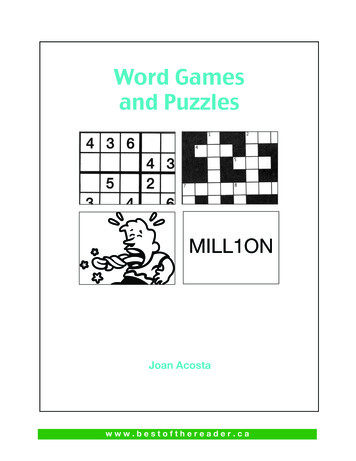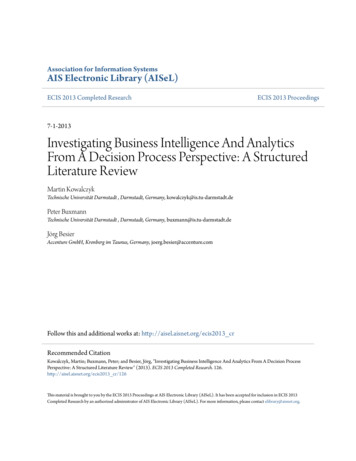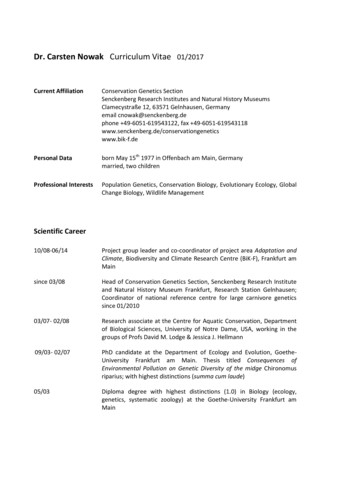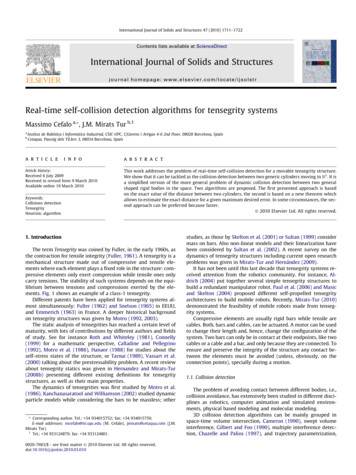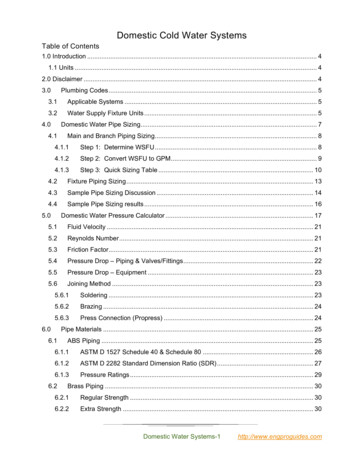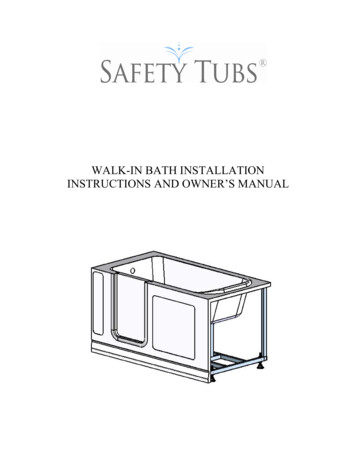
Transcription
SudokuJordi CortadellaDepartment of Computer Science
Solving a 803001700020006060000280000419005000080079 Is it correct (conflict free)? Can we find a solution?Introduction to Programming Dept. CS, UPC2
Sudoku: data structures// A 9x9 matrix to store values.// The matrix contains values in {0, ,9},// where 0 means “empty”.using Grid vector vector int ;Introduction to Programming Dept. CS, UPC3
Detection of conflicts05 3761 9 59 86864837262 84 1 98731659123 45678 9 Boolean matrix for row conflictsSimilar matrices can be used for column and square conflicts// A 9x10 Boolean matrix to indicate used values.// The 0-column is not used.using Used vector vector bool ;Introduction to Programming Dept. CS, UPC4
Sudoku: data structuresstructGridUsedUsedUsed};Sudoku {G;Rows;Columns;Squares;////////the main gridconflicts for rowsconflicts for columnsconflicts for squares// Post: The Sudoku initialized as empty.void initSudoku(Sudoku& S) {S.G Grid(9, vector int (9, 0));S.Rows Used(9, vector bool (10, false));S.Columns Used(9, vector bool (10, false));S.Squares Used(9, vector bool (10, false));}Introduction to Programming Dept. CS, UPC5
Sudoku: indexing the Used matrices0134672v58structGridUsedUsedUsed};Sudoku {G;Rows;Columns;Squares;////////the main gridconflicts for rowsconflicts for columnsconflicts for squaresSudoku S;row r, column c, value vFor row conflicts S.Rows[r][v]For column conflicts S.Columns[c][v]For square conflicts S.Squares[3 (r/3) c/3][v]Introduction to Programming Dept. CS, UPC6
Sudoku: writing a cellstructGridUsedUsedUsed};Sudoku {G;Rows;Columns;Squares;////////the main gridconflicts for rowsconflicts for columnsconflicts for squares// Pre: S is a Sudoku partially filled in.// Post: Cell (r,c) is filled in with value v if no conflict is//produced. The Sudoku is not changed in case of conflict.// Returns true if no conflict, or false otherwise.bool writeCell(Sudoku& S, int r, int c, int v) {int sq 3 (r/3) c/3;if (S.Rows[r][v] or S.Columns[c][v] or S.Squares[sq][v]) return false;S.Rows[r][v] S.Columns[c][v] S.Squares[sq][v] true;S.G[r][c] v;return true;}Introduction to Programming Dept. CS, UPC7
Sudoku: erasing a cellstructGridUsedUsedUsed};Sudoku {G;Rows;Columns;Squares;////////the main gridconflicts for rowsconflicts for columnsconflicts for squares// Pre: The Sudoku S has a value in cell (r,c).// Post: Cell (r,c) has been erased.void eraseCell(Sudoku& S, int r, int c) {int v S.G[r][c]; // Gets the valueS.G[r][c] 0;// Erases the value// Cleans the conflict matrices for the valueint sq 3*(r/3) c/3;S.Rows[r][v] S.Columns[c][v] S.Squares[sq][v] false;}Introduction to Programming Dept. CS, UPC8
Reading a 1700020006060000280000419005000080079Introduction to Programming Dept. CS, UPC9
Reading a Sudoku// Pre: the input has 81 digits in {‘0’, ,‘9’}// Post: The Sudoku S has been read from cin.// Returns true if the Sudoku is correct, or false otherwise.bool readSudoku(Sudoku& S) {initSudoku(S); // empty Sudokufor (int r 0; r 9; r) { // Read all rows and columnsfor (int c 0; c 9; c) {char digit;cin digit;int n int(digit - '0'); // Convert to intif (n ! 0 and not writeCell(S, r, c, n)) return false;}}return true; // Correct sudoku}Introduction to Programming Dept. CS, UPC10
Write a Sudoku// Pre: S is a complete Sudoku.// Post: The Sudoku has been printed into cout.void writeSudoku(const Sudoku& S) {for (int r 0; r 9; r) {for (int c 0; c 9; c) cout S.G[r][c];cout endl;}}Introduction to Programming Dept. CS, UPC11
Introduction to Programming Dept. CS, UPC12
Main program// The program reads a Sudoku and tries to solve it.// In case it is solvable, it writes a solution.int main() {Sudoku S;if (not readSudoku(S)) {cout “The initial Sudoku is incorrect.” endl;} else if (not solveSudoku(S)) {cout “The Sudoku has no valid solution.” endl;} else {writeSudoku(S);}}Introduction to Programming Dept. CS, UPC13
Number of Sudokus123456789r 0, c 0 134567891345789 r 0, c 1 r 0, c 2 6,670,903,752,021,072,936,960 6.67 1021Introduction to Programming Dept. CS, UPC14
Solving a Sudoku Doing progress from apartially filled Sudoku4 68 9 1 27 23 4 8213394 1212 11211 2 3 9(r 2,c 0)3(r 2,c 3)1 2 3 4 (r 2,c 4)12 (r 2,c 5) Dept. CS, UPC Introduction to Programming15
Solving a Sudoku Doing progress from apartially filled Sudoku4 68 9 1 27 23 4 8213394 1212 11211 2 3 9(r 2,c 0)3(r 2,c 3)1 2 3 4 (r 2,c 4)12 (r 2,c 5) Dept. CS, UPC Introduction to Programming16
Recursive Sudoku// Pre: S has been filled in up to cell (r,c) without conflicts,without including cell (r,c).// Returns true if the Sudoku is solvable with the// pre-filled cells, or false otherwise.// Post: S contains a solution if the Sudoku is solvable.//S is not modified if the Sudoku is unsolvable.bool solveSudokuRec(Sudoku& S, int r, int c);(r,c)Cells are filled in by rows, starting from cell (0,0).Introduction to Programming Dept. CS, UPC17
Recursive SudokuBasic case: (r 9, c 0)– The Sudoku has been completed without conflicts.A solution has been found! We are done (return true).(r 9,c 0)Introduction to Programming Dept. CS, UPC18
Recursive SudokuSimple case: cell is not empty– Don’t touch and solve from the next cell4Introduction to Programming4 Dept. CS, UPC19
Recursive SudokuDifficult case: cell is empty– Write 1 in (r,c) and check for conflicts.If no conflict, solve from next cell. If successful, done! (return true)– else, erase 1, write 2 in (r,c) and check for conflicts.If no conflict, solve from next cell. If successful, done! (return true)– – else, erase 8, write 9 in (r,c) and check for conflicts.If no conflict, solve from next cell. If successful, done! (return true)– else, failure (return false).?Introduction to Programming Dept. CS, UPC20
Recursive Sudokubool solveSudokuRec(Sudoku& S, int r, int c) {if (r 9) return true; // Yupee! (Sudoku completed)int next r r c/8;int next c (c 1)%9;// Next row (increase when c 8)// Next column (0 if c 1 9)// If cell is not empty, don’t touch and go to next cellif (S.G[r][c] ! 0) return solveSudokuRec(S, next r, next c);// Try all possible values from 1 to 9for (int v 1; v 9; v) {if (writeCell(S, r, c, v)) {if (solveSudokuRec(S, next r, next c)) return true; // Yupee!eraseCell(S, r, c); // Backtrackc}}rreturn false;?}Introduction to Programming Dept. CS, UPC21
Back to main programint main() {Sudoku S;if (not readSudoku(S)) {cout “The initial Sudoku is incorrect.” endl;} else if (not solveSudoku(S)) {cout “The Sudoku cannot be solved.” endl;} else {writeSudoku(S);}}// Pre: S is a correct and possibly incomplete Sudoku.// Returns true if the Sudoku is solvable, or false otherwise.// Post: If solvable, the S contains a solution.bool solveSudoku(Sudoku& S) {return solveSudokuRec(S, 0, 0);}Introduction to Programming Dept. CS, UPC22
Try from hereSource: http://www.7sudoku.com/very-difficultIntroduction to Programming Dept. CS, UPC23
The 8 queens puzzlePlace eight queens on an 8 8 chessboardso that no two queens threaten each otherIntroduction to Programming Dept. CS, UPC24
Generalization to n queensn 6n 13Introduction to Programmingn 25 Dept. CS, UPC25
The 8 queens in actionIntroduction to Programming Dept. CS, UPC26
Solving a mazeSDIntroduction to Programming Dept. CS, UPC27
Solving a mazeIntroduction to Programming Dept. CS, UPC28
Summary Backtracking is a common technique used tosolve constraint satisfaction problems. Strategy: build partial solutions and backtrackwhen some constraint is not satisfied. Backtracking avoids the exhaustiveenumeration of all possible solutions.Introduction to Programming Dept. CS, UPC29
Detection of conflicts 5 3 7 6 1 9 5 9 8 6 8 6 3 4 8 3 1 7 2 6
